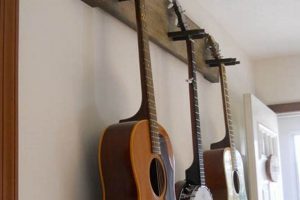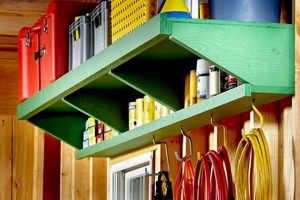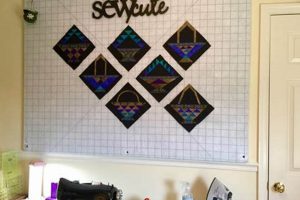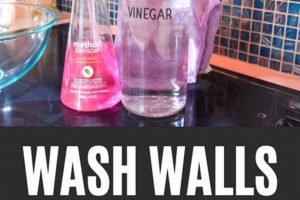The concept involves creating decorative artwork for walls using cloth as the primary medium. This undertaking encompasses a wide array of techniques, from stretching fabric over frames to intricate textile collages. As an example, a piece could involve carefully selected patterned textiles arranged to form an abstract composition adhered to a wooden backing.
This practice offers an accessible avenue for personalizing interior spaces with unique aesthetic expressions. It leverages readily available materials, potentially repurposing existing textiles, leading to cost-effective and environmentally conscious design choices. The historical context reveals roots in quilting and tapestry traditions, evolving into a modern form of self-expression and interior embellishment.
The subsequent sections will delve into specific methods for realizing such projects, considering material selection, framing techniques, and design principles to guide the creation of compelling and personalized adornments.
Fabric Wall Art Creation
Successful execution of fabric-based wall decor relies on meticulous planning and attention to detail. The following guidelines provide a framework for achieving professional-quality results.
Tip 1: Material Selection: The choice of fabric dictates the aesthetic and durability of the finished piece. Consider factors such as weight, texture, and pattern to align with the desired style and the intended environment. For high-traffic areas, opt for robust, stain-resistant options.
Tip 2: Frame Integrity: A sturdy frame is crucial for maintaining the tension and shape of the fabric. Wood frames are generally preferred, ensuring accurate dimensions and resistance to warping. Consider pre-made canvas frames to simplify the process.
Tip 3: Tension Control: Uniform tension is essential to prevent sagging or wrinkles. Employ tools like canvas stretching pliers to ensure even distribution of force when securing the fabric to the frame. Monitor tension over time, as fabric can relax.
Tip 4: Pattern Placement: Carefully plan the placement of patterns or motifs on the fabric. Precise alignment is crucial, especially for geometric designs. Utilize a ruler and marking tools to guide the cutting and stretching process.
Tip 5: Edge Finishing: Neatly finished edges contribute to the overall aesthetic and prevent fraying. Options include folding and gluing, or the application of fabric sealant to exposed edges. Consider using decorative trim or gimp to conceal the edges.
Tip 6: Adhesive Selection: Choosing an appropriate adhesive is critical. Opt for acid-free adhesives to prevent discoloration or degradation of the fabric over time. Test the adhesive on a small, inconspicuous area of the fabric before widespread application.
Tip 7: Seam Management: For larger pieces requiring multiple fabric panels, carefully plan and execute seams. Employ a sewing machine to create durable, inconspicuous seams. Press seams flat to minimize bulk and ensure a smooth surface.
Adhering to these principles enhances the likelihood of producing visually appealing and structurally sound fabric-based wall decor. Careful planning and precise execution are paramount.
The subsequent and concluding section summarizes these insights to guide readers towards confident project completion.
1. Texture
Texture plays a pivotal role in the perception and aesthetic value of textile wall art. The tactile quality of fabric significantly influences the visual weight and perceived depth of a piece. Coarse textures, such as burlap or canvas, introduce a rustic or organic feel, while smoother textures, like silk or satin, convey a sense of elegance and refinement. The deliberate selection of a specific texture can amplify the intended message or evoke a particular emotion. For example, a deeply textured weave in a monochromatic piece might emphasize form and shadow, creating a dramatic visual effect. Conversely, a smooth, reflective surface could highlight vibrant colors and intricate patterns. Therefore, understanding the cause and effect relationship between texture and visual impact is vital to design.
Real-world applications demonstrate the practical significance of understanding texture in textile art. Consider a large-scale wall hanging in a minimalist space. A subtly textured linen fabric, stretched over a frame, adds a layer of visual interest without overwhelming the clean lines of the room. In contrast, a children’s room might benefit from a quilted wall panel with raised patterns, providing both visual and tactile stimulation. The ability to manipulate textures allows the artist to control the focal point and balance within a design, creating an appealing sensory experience for the viewer. The choice of textures is not merely a decorative decision; it fundamentally shapes the character of the artwork.
In summary, texture is not an ancillary aspect but a primary component in the creation of engaging wall art. The intentional use of different textures can transform a simple fabric-covered frame into a sophisticated visual statement. Challenges arise in balancing contrasting textures and ensuring the chosen texture complements the surrounding environment. Understanding texture’s impact is crucial for creating meaningful and visually compelling fabric-based artwork. Texture contributes significantly to the final overall aesthetic value of any textile art and should be considered at the beginning of the art conception and design.
2. Color palette
The selection of a color palette exerts a significant influence on the overall aesthetic and emotional impact of fabric wall art. The interplay of hues and their respective intensities determines the visual hierarchy, mood, and stylistic direction of the piece. A carefully curated palette can establish harmony with the surrounding environment or create a deliberate contrast to draw the eye. For instance, a monochromatic scheme using varying shades of gray can evoke a sense of sophistication and calmness, while a vibrant palette with complementary colors may generate a feeling of energy and excitement. The psychological effects of color, such as blue’s association with tranquility or red’s association with passion, should be considered when selecting a color scheme. This careful selection has the power to change the entire look and feel of your DIY project.
Real-world examples illustrate the practical significance of understanding color relationships in fabric art. A living room with neutral-toned furniture might benefit from fabric wall art featuring analogous colors, such as blues and greens, to create a cohesive and relaxing atmosphere. Alternatively, a stark, modern space could be enlivened with a piece incorporating a bold, contrasting color like yellow or orange. In these scenarios, the color palette serves as more than mere decoration; it functions as a critical design element that shapes the perception and experience of the space. A common color scheme could be blues and beiges, but this depends on the personal touch for the piece of fabric wall art.
In summary, the color palette is not simply a decorative choice but a fundamental component of fabric wall art. Thoughtful selection and application of color can profoundly affect the visual and emotional impact of the artwork. Challenges arise in balancing contrasting colors and ensuring the chosen palette complements the intended environment. A sound comprehension of color theory and its practical applications allows the creator to make informed decisions that elevate the final outcome. The integration of colors is vital to DIY fabric wall art.
3. Frame stability
Frame stability constitutes a foundational element in the creation of durable and aesthetically pleasing fabric wall art. The structural integrity of the frame directly influences the fabric’s tension, preventing sagging or warping over time. An unstable frame can compromise the artwork’s visual appeal and reduce its lifespan. For example, a lightweight or poorly constructed wooden frame may bend under the stress of stretched fabric, leading to distortion of the design. The choice of frame material and construction methods significantly impacts the long-term integrity of the finished piece. This applies not only to large canvas pieces, but also to small framed art, such as embroidery.
Consider a scenario in which a large piece of patterned fabric is stretched over a frame made of thin, untreated wood. Over time, the wood may warp due to changes in humidity, causing the fabric to loosen and the pattern to appear distorted. Conversely, a frame constructed from kiln-dried hardwood and reinforced with corner bracing will maintain its shape and tension, preserving the fabric’s integrity. In practical applications, ensuring frame stability involves selecting appropriate materials, employing robust joinery techniques, and potentially incorporating support structures for larger pieces. A stable frame will greatly increase the long-term beauty and display value of your wall art.
In summary, frame stability is not a secondary consideration, but a primary determinant of the quality and longevity of fabric wall art. Challenges arise in selecting the appropriate frame material and construction methods for specific fabric types and sizes. A thorough understanding of frame construction principles and their relationship to fabric tension allows for the creation of enduring and visually compelling textile artwork. The stability of the frame contributes heavily to the final product and perceived value.
4. Pattern alignment
Accurate pattern alignment is a pivotal aspect of crafting visually compelling fabric wall art. The precise matching and arrangement of motifs significantly influence the overall aesthetic appeal and perceived quality of the finished piece. Deviations from perfect alignment can detract from the intended design and undermine the artistic intent.
- Seam Matching in Multi-Panel Designs
When fabric wall art incorporates multiple panels, meticulous seam matching becomes essential. The pattern must seamlessly transition from one panel to the next to create a cohesive visual narrative. Failure to align patterns across seams results in a disjointed appearance, disrupting the flow of the design. For instance, in a landscape mural spanning several panels, the horizon line and prominent features must align perfectly to maintain the illusion of continuity. The execution of this task is directly reflective of the quality and precision of the art.
- Centering and Placement on Frames
The deliberate centering and placement of patterns on the frame contribute to visual balance and harmony. When stretching fabric over a frame, the central motif or focal point should be precisely positioned to draw the eye and create a sense of equilibrium. Off-center patterns can create a feeling of unease or imbalance, diminishing the artwork’s impact. The correct placement of a pattern will create symmetry and improve how visually appealing it is.
- Mitigating Distortion During Stretching
Stretching fabric over a frame inevitably introduces some degree of distortion, particularly with patterned fabrics. The tension applied during the stretching process can alter the dimensions of the pattern, leading to misalignment or warping. Careful planning and execution are required to minimize distortion and maintain the integrity of the pattern. Pre-stretching and consistent tensioning techniques can help mitigate these effects, ensuring that the pattern remains true to its original form. A pattern could become unaligned or misshapen if improperly stretched.
- Symmetry and Repetition in Geometric Patterns
Geometric patterns rely heavily on symmetry and precise repetition to achieve their intended effect. Any deviation from perfect symmetry or consistent repetition will become immediately apparent, detracting from the overall design. Accurate cutting, measuring, and placement are crucial for maintaining the integrity of geometric patterns in fabric wall art. Even slight inaccuracies can compromise the visual impact and diminish the perceived quality of the artwork. When designing geometric art, pattern alignment is imperative.
These facets underscore the criticality of pattern alignment in the creation of fabric wall art. By carefully considering seam matching, centering, distortion mitigation, and symmetry, creators can ensure that their artwork achieves its intended aesthetic and visual impact. These steps are crucial for art in the DIY community and beyond.
5. Adhesive quality
The selection of an appropriate adhesive is paramount in the realm of fabric wall art. The adhesive’s characteristics directly influence the artwork’s structural integrity and longevity. An inadequate adhesive can lead to delamination, discoloration, or degradation of the fabric, compromising the aesthetic and physical properties of the piece. The adhesive’s chemical composition interacts with the fabric fibers, potentially causing irreversible damage if not carefully considered. For instance, an adhesive with high acidity can weaken delicate natural fibers over time, leading to premature deterioration.
Consider the practical application of adhering a large piece of printed cotton fabric to a wooden panel. An adhesive with insufficient bonding strength will allow the fabric to peel away from the wood, particularly in areas subjected to stress or humidity changes. Conversely, an adhesive with excessive tackiness may bleed through the fabric, leaving unsightly stains. The ideal adhesive will provide a strong, durable bond without altering the fabric’s appearance or texture. Examples of suitable choices include pH-neutral adhesives specifically formulated for textiles or archival-quality glues designed for preserving delicate materials. Furthermore, the application method, whether spray, brush, or roll-on, should be carefully chosen to ensure even distribution and prevent saturation of the fabric.
In summary, adhesive quality represents a critical determinant of the success and longevity of fabric wall art. Selecting an adhesive that is compatible with the chosen fabric, provides a strong bond, and resists discoloration is essential for preserving the artwork’s integrity. Challenges arise in identifying appropriate adhesives for diverse fabric types and understanding the long-term effects of different chemical compositions. A thorough understanding of adhesive properties and their interaction with textiles enables the creation of enduring and visually appealing fabric wall art.
6. Edge finish
Edge finish, often an overlooked detail, significantly contributes to the professional appearance and longevity of fabric wall art. The method employed to treat the raw edges of the fabric directly impacts the aesthetic appeal and prevents unraveling, thereby ensuring the artwork’s durability. Neglecting this aspect can result in a visually unrefined product prone to premature wear and tear.
- Concealed Edge Techniques
Concealed edge techniques, such as wrapping the fabric around the back of a frame and securing it, offer a clean, minimalist aesthetic. This approach eliminates visible raw edges, presenting a polished and professional look. Examples include stretching canvas around a wooden frame and stapling it to the back, or folding and gluing the edges of fabric onto a board. The absence of visible seams or hems enhances the overall sophistication of the piece, contributing to a higher perceived value.
- Decorative Edge Treatments
Decorative edge treatments, conversely, intentionally expose the edges of the fabric, adding a textural or stylistic element to the artwork. Techniques like adding trim, fringe, or piping can enhance the visual interest and complement the fabric’s design. For example, attaching a contrasting colored trim along the edges of a geometric fabric panel can accentuate its shape and create a more defined boundary. This approach allows for creative expression and can personalize the wall art to match the surrounding dcor.
- Sealing and Stabilizing Edges
Sealing and stabilizing edges prevent fraying and unraveling, extending the lifespan of the fabric wall art. Methods such as applying fabric sealant, serging, or using a zigzag stitch can reinforce the edges and prevent them from deteriorating over time. This is particularly important for fabrics prone to fraying, such as linen or loosely woven materials. Properly stabilized edges maintain the artwork’s integrity and prevent the gradual degradation that can detract from its appearance.
- Considerations for Different Fabric Types
The selection of an appropriate edge finish depends on the type of fabric used. Delicate fabrics like silk require gentler treatments, such as hand-rolled hems or narrow serged edges, to prevent damage. Heavier fabrics like canvas can withstand more robust techniques, such as folding and gluing or using decorative trim. Understanding the properties of different fabric types and their susceptibility to fraying or stretching is crucial for selecting the most effective edge finish.
In conclusion, the choice of edge finish significantly influences the aesthetic appeal and durability of fabric wall art. Whether opting for concealed techniques, decorative treatments, or edge stabilization methods, careful consideration of the fabric type and desired aesthetic is essential for creating a polished and long-lasting artwork. By addressing this often-overlooked detail, individuals can elevate the quality and value of their fabric wall art projects.
DIY Fabric Wall Art
The following section addresses common inquiries regarding the creation and maintenance of fabric-based wall decor, providing clarity on crucial aspects of the process.
Question 1: What is the optimal method for preventing fabric from sagging on a stretched canvas frame?
The application of consistent tension during the stretching process is paramount. Canvas stretching pliers and a staple gun are effective tools. Additionally, sealing the back of the canvas with a moisture-resistant coating can minimize fabric relaxation due to humidity fluctuations.
Question 2: Which adhesive types are recommended for adhering fabric to various backing materials without causing discoloration or damage?
Acid-free adhesives specifically formulated for textiles are generally preferred. These adhesives minimize the risk of discoloration or degradation of the fabric over time. Testing the adhesive on a small, inconspicuous area is advisable before widespread application.
Question 3: How does one effectively manage pattern alignment when creating multi-panel fabric wall art?
Precise measurement and careful planning are essential. Utilizing a grid system or marking guidelines on the fabric can facilitate accurate alignment. Seam allowances should be consistent across all panels to ensure seamless pattern transitions.
Question 4: What are the recommended techniques for preventing fabric edges from fraying on exposed edges of wall art?
Several options exist, including serging, zigzag stitching, or applying a fabric sealant. The choice depends on the fabric type and the desired aesthetic. Decorative trims can also be used to conceal and protect raw edges.
Question 5: What factors should be considered when selecting a frame for fabric wall art to ensure adequate support and prevent warping?
Kiln-dried hardwood frames are generally recommended for their stability and resistance to warping. Corner bracing and reinforced joinery can further enhance frame integrity, especially for larger pieces. The frame’s depth should also be sufficient to accommodate the fabric’s thickness and prevent bulging.
Question 6: How can fabric wall art be effectively cleaned and maintained to preserve its appearance over time?
Regular dusting with a soft brush or vacuum cleaner attachment is recommended. For stains, spot cleaning with a mild detergent and water is advisable. Avoid harsh chemicals or abrasive cleaners, as they can damage the fabric. Direct sunlight should also be avoided to prevent fading.
These FAQs provide a foundation for addressing common concerns and ensuring the successful creation and maintenance of fabric wall art. Careful adherence to these guidelines will contribute to the longevity and aesthetic appeal of the artwork.
The subsequent and final section provides a conclusion to the overall topic.
Conclusion
This exploration of “diy fabric wall art” has underscored the critical elements that contribute to successful creation and longevity. The interplay of material selection, frame integrity, pattern alignment, and appropriate finishing techniques has been examined. These factors collectively determine the aesthetic appeal and structural soundness of such artistic endeavors.
The information presented serves as a practical guide for those seeking to engage in this art form. The application of these principles allows for the transformation of textiles into enduring and visually compelling expressions. Further exploration of advanced techniques and innovative material combinations promises continued evolution within this craft.







